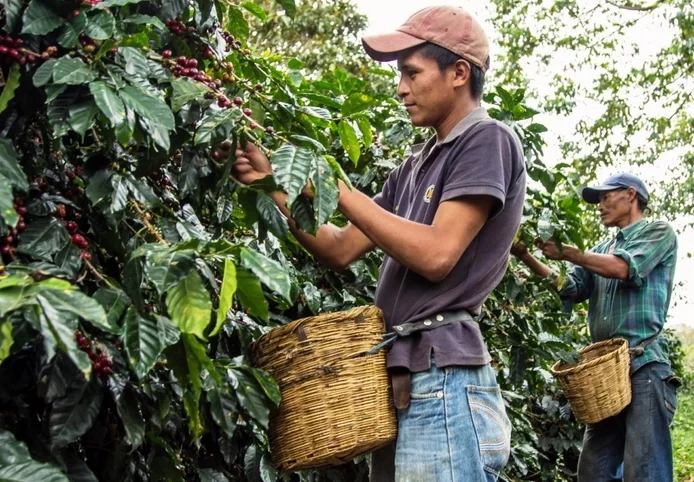Growing Your Own Cup Of Coffee
by Bryan Albuquerque
Hi folks! It's me Reggie again and I am sitting beside the beautiful Iguacu Falls on the border between Brazil and Argentina, sipping on my coffee and thinking about what went into making this delicious nectar.
Contents
Brazil is the top grower and exporter of coffee beans in the world and with rising consumption world wide and obvious climate changes, the coffee industry seems to be in trouble.
A cup of coffee in North America is next to nothing which discourages farmers and governments from getting into the business. They even have global coffee forums to figure out what to do about the world's most popular drink. The severe Brazilian drought of 2014, forced the price of Arabica coffee in New York up 50%. If you've been following the blog here on this site, we've talked about how Brazil is one of the countries that produces some of the best beans on the planet, so the fact that their beans might be in jeopardy in some way really stresses me out.
With production falling and prices rising, consumption is still increasing, with predictions of 200 million bags per year by 2030. The experts are counting on the small farmers around the world to boost their production. I thought I would let you in on what that small coffee farmer needs to do to produce one fine cup of coffee.
The first step in making a great cup of coffee is to harvest the cherries from the plant and extract the bean from the cherry by putting it through a machine.

So let's go into the coffee orchard and pick some ripe red cherries from the coffee plant. This isn't that difficult since the coffee plants are about as tall as an average person. You could attach a cherry basket to yourself with the harness on your back and the basket on your front allowing both hands to be free for the picking.
The perfect day for coffee would be a cloudy, cool, 20 degree C. with rain. The coffee orchards are at an elevation of about 1800-3600 feet, with an annual rainfall of around 150 inches. The coffee tree has been allowed to grow to about 6 feet tall by cutting it down every year to the stump forcing new sprouts or branches to form. The leaves are oval and a shiny green color. Keeping the tree rather small enables the tree to produce lots of fruit every year.
The coffee pickers are very important to the great cup of coffee. Since they get paid by the weight, they might choose to pick some of the green cherries instead of just the red ones which make the best tasting coffee. It is the same for harvesting blueberries, cherries, or even apples. Ten harvesters can pick up to 2000 pounds per day. After the coffee cherries have been picked, that have to be milled to get the bean hiding inside the cherry. The mill is just a simple machine that carefully peels the cherry husk away to release the coffee bean. When the beans come out of the mill, they are a light green colour and about the size of your fingernail. The green coffee beans need to be dried. You could just lie them in the sun for about four days. Make sure they are lying up off the groups so that the air can circulate all around them.
If you examine the dried bean carefully, it has a tan color thin coat protecting the bean known as parchment. If you wish to store coffee beans, leave the parchment on but it needs to come off when you're ready to roast the beans. The bean with the parchment removed is called "green coffee". The green coffee bean still has a very fine skin covering it known as "silver skin" which will fall off the bean naturally during the roasting process. A small hair drier will blow the silver skin away if it bothers you at all. Now it is time for roasting.
If you chose to roast your beans in a non-stick frying pan, keep the heat to low and move the beans around for about 4 minutes until they turn brown. This is when the silver skin chaff will fall off. As you stir the beans with a wooden spoon, they will begin to crack and pop. Once the popping has stopped, place the beans into a colander and let them cool. Move them around the colander allowing the silver skin to sift away. It is time to grind up what you need.
The grinder you chose will determine how fine you want the bean powder to be. A general rule to follow is - the finer the bean, the more flavor the coffee will have. The boiling water or even water at room temperature you use is also key to perfection. Of course you will place the ground up beans in a filter system before you pour the water over them. And there you have it, a cup of fine Arabica coffee.
If this all sounds way too technical for you and you just don't need the extra work, or you can't afford a trip to Iguacu Falls, you could treat yourself to a cup of Iguacu Arabica coffee from Brazil available on Amazon.com at this link …
Buen Apetito!!!
Click the logo below to return to our blog
More from my site
 |
 |
 |
 |

About Bryan Albuquerque
Bryan Albuquerque is a coffee lover and vaping advocate who writes reviews and information about coffee accessories and KYG. A former coffee addict, Bryan traded his morning fix for an electronic cigarette in an effort to quit smoking, and has never looked back. He's dedicated to helping others make the switch to vaping, and believes that it's one of the best decisions anyone can make for their health.
Thoughts on "Growing Your Own Cup Of Coffee"
 |
 |
 |
 |
Get FREE Coffee Gifts now. Or latest free grinders from our best collections.
Disable Ad block to get all the secrets. Once done, hit any button below
 |
 |
 |
 |